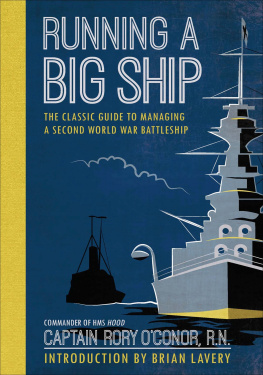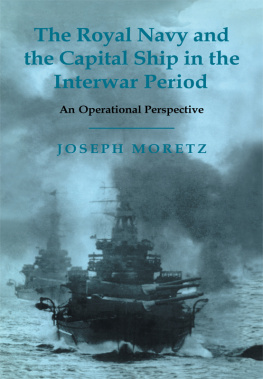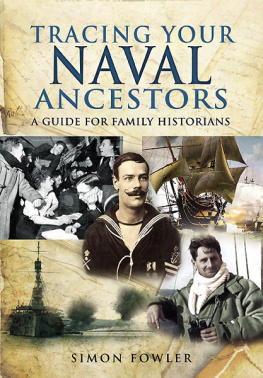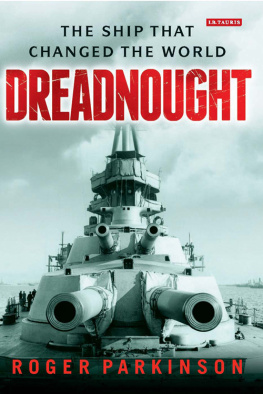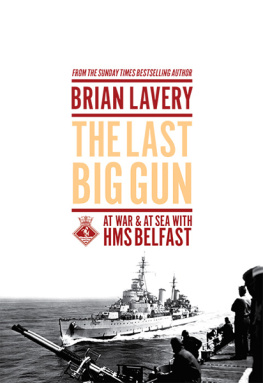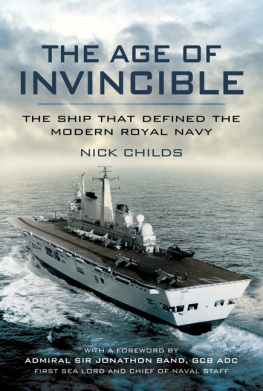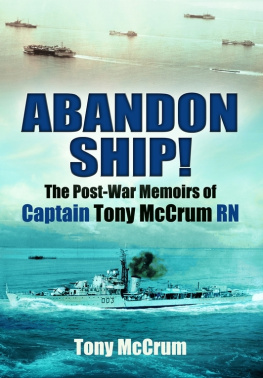
Published in Great Britain in 2017 by
CASEMATE PUBLISHERS
The Old Music Hall, 106108 Cowley Road, Oxford OX4 1JE, UK
Originally published under the title Running a Big Ship On Ten Commandments (With Modern Executive Ideas and A Complete Organisation) (Portsmouth: Gieves Ltd, 1937)
Casemate Publishers 2017
Introduction Brian Lavery 2017
Hardback Edition: ISBN 978-1-91086-019-9
Digital Edition: ISBN 978-1-61200-573-7 (epub)
A CIP record for this book is available from the British Library
All rights reserved. No part of this book may be reproduced or transmitted in any form or by any means, electronic or mechanical including photocopying, recording or by any information storage and retrieval system, without permission from the publisher in writing.
Printed in the Czech Republic by FINIDR, s.r.o.
Typeset in India by Lapiz Digital Services, Chennai
For a complete list of Casemate titles, please contact:
CASEMATE PUBLISHERS (UK)
Telephone (01865) 241249
Fax (01865) 794449
Email:
www.casematepublishers.co.uk
INTRODUCTION
by Brian Lavery
RORY OConor, the author of Running a Big Ship (1937), was the son of a distinguished Irish surgeon. He entered the Naval College at Osborne on the Isle of Wight in September 1911 at the age of 13, and went on to Dartmouth three years later. He had first-class marks in seamanship, navigation and gunnery, but only a second in torpedo (which included a good deal of electrical work) and somehow missed out on engineering, perhaps because he, like all his colleagues, was rapidly promoted to midshipman on the outbreak of war in 1914 and sent to the fleet. OConor served three years in the old pre-Dreadnought battleship Prince of Wales, including the Dardanelles campaign. At first, he was only regarded as average, but soon began to attract attention as likely to make a good, steady and reliable officer. He was commissioned as sub-lieutenant in 1917, and in the destroyers Vivid and Walpole he was regarded as exceptional. After the war, there was some attempt to make up for OConors lack of engineering knowledge when he was posted to the great battleship Barham for work in the engine room, then to the royal yacht Victoria and Albert for the same purpose. But when it was time for him to apply for a specialisation, it was made clear that he was not a candidate for the engineering branch, which would soon be separated from the seamen branch and greatly reduced in status. Instead, he went to HMS Excellent, the shore-based gunnery school at Portsmouth, to join the branch which regarded itself as the elite of the Royal Navy. By this time his references were invariably glowing, for example by Captain Dalglish in 1921:
I have the highest opinion of this officer. Exceedingly capable and efficient; has an exceptionally good command of men; strict disciplinarian and a marked success as a divisional officer. Energetic, keen, hardworking and good organiser.
OConor was a keen sportsman and remained a bachelor, which meant that his work for the navy was undistracted. He went on to serve as the gunnery officer of the Resolution, Emerald and Royal Sovereign, with time on the staff of Excellent, until the end of 1931 when he was promoted to commander and offered one of the best appointments in the Royal Navy.
HMS Hood was the star ship of the fleet, one of only three capital ships completed since the end of World War I. The battleships Rodney and Nelson were more powerful with their 16-inch guns and had much better armour protection, but they were modified during design to meet the restrictions of the Washington Treaty of 1922 and were known to the lower deck as the pair of boots or the ugly sisters. Hood, in contrast, was described by Derek Rayner of the Royal Naval Volunteer Reserve as the most beautiful steamship that man ever devised.
The commander of a battleship or cruiser was in fact the second-in-command of the ship, the head of the executive or seamen branch. As the chief organiser and motivator of the crew, he was far closer to the men than the captain, who was a remote figure. But OConor only had a general responsibility for the non-seaman branches such as engineering and the Royal Marines, which is reflected in the text of Running a Big Ship where they are hardly mentioned. An unspoken factor was the shadow of the Invergordon Mutiny of 1931. Hood had not been one of the leading ships when the men of the Atlantic Fleet refused to raise anchor, but her crew had followed the example of the Rodney, Nelson and Valiant. The mutiny was mainly about pay cuts which were to a certain extent rectified, but the effect on officers of losing their almost divine authority was traumatic. Moreover, it was recognised that the bad management and arrogance of some officers was a factor. Admiral Sir John Kelly described a failure to attend to the wants and grievances of the men, and rowdy parties in officers messes, which would have led to disciplinary action if repeated on the lower deck. Such behaviour, according to Kelly, would never earn the praise, Hes a proper gent, he is.
In fact, the Hood had been quite well run under Commander McCrum, but OConor began to apply a liberal regime, sympathetic to the men. He had some support from Admiral Sir William James who used the Hood as his flagship and had himself written New Battleship Organisations about the battle cruiser Queen Mary before the First World War.
OConor left the Hood in 1936 and was keen to publicise his views on how ships should be run. He was given six months paid leave to write the book, which he did in a study bedroom in his family home on the Isle of Wight, with the other occupants warned not to disturb him except in an emergency.
OConor and Pridham had very different philosophies, but the notes for newly joined officers compiled by Pridham in 1938 turned out to be more influential in the short term. Pridham was dealing with a different situation, of rapid expansion and in particular a shortage of experienced petty officers. His Notes became the basis for a document issued to the hundreds of trainee wartime officers in HMS King Alfred in 1943, and are still regarded as Timeless wisdom in leadership. Cruisers did however expand in numbers and Running a Big Ship was more relevant there. On the whole, the book reflects the peacetime era preceding the great naval expansion that began in 1936. It was also more relevant to the post-war era, not in its references to big ships which became increasingly rare, but in its concern for welfare, the education of young officers, the need for more practical uniforms and many other matters.
OConor went on to become a staff officer on the Joint Planning Committee in 193840 and was described as a cheerful, willing and unusually able staff officer, with great powers of work. He has a wide grasp of strategical problems and inclines to orthodox views and the rejection of any ideas tainted with unsoundness. In May 1940, he took command of the cruiser Neptune, where he was very effective but his lack of recent experience in ship handling proved a drawback contrary to the tradition that the captain should direct the ship himself, he used his navigating officer to guide him during difficult manoeuvres. He was lost when the Neptune struck a mine in the Mediterranean in December 1941. If he had lived, he would almost certainly have risen to high rank and his experience and ideas would have proved invaluable in the much-needed social reform of the post-war navy.
Next page
